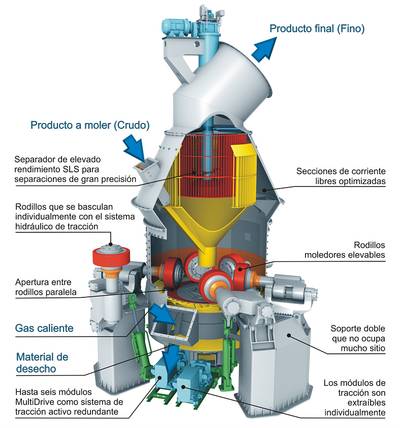Industry Reports
High-Efficiency Roller Mills's usage in nowadays
1. Traditionally, ball mills are used in cement industry for raw material, fuel and product grinding. Ball mills use an established technology and offer certain advantages. However, they have higher energy demands. By using an appropriate kind of the more efficient roller mill technologies – either as a replacement or in combination with ball mills – considerable energy savings can be achieved without compromising product quality. The following roller mill concepts are applicable to cement manufacturing:

2. Vertical roller mills: In these mills materials are crushed between a rotating grinding table and 2 to 6 grinding rollers positioned slightly less than 90 degrees from the table surface and pressed hydraulically against it. Main advantages of vertical roller mills include:
relatively low power consumption (less than 10 kWh/t – for medium raw material hardness and medium fineness);
ability to combine grinding, drying (using waste heat from kiln system) and separation;
ability to manage larger variations in mass flow rate (30 to 100% of mill capacity).
Vertical roller mills are available in a wide range of capacities – 5 to 1200 t/h.
According to National Development Reform Commission of China, VRMs have the following generic power consumption values when used for different purposes in a 6:
for raw material grinding, power consumption may range between 14 ~ 17kWh/t-material;
for coal grinding, power consumption may range between 20 ~ 22kWh/t-coal;
slag grinding, electricity consumption may range between 39 ~ 45kWh/t-slag.
The life-time of the wear resistant material is reported to vary between 8000 to 12000 hours. (NDRC,2008. p.50).
In China, market penetration of VRMs within the building materials sector was expected to reach 50% during the eleventh five-year development period, requiring an investment of around 1.08 billion RMB, and holding a potential to reduce energy consumption by 500 GWh (NDRC, p.51).
VRMs are installed in new cement plants with dry systems, and also often replace ball mills during plant modernization, where the raw material moisture content is less than 25%. As of 2010, VRMs for raw material preparation had a penetration rate of 45% in Chinese market. During the twelfth five-year period, the market penetration of the technology is expected to reach 80% (MIIT, 2012. p.20)
Horizontal roller mills: Here materials are crushed inside of a rotating mill tube which also contains a grinding roller that is hydraulically pressed against the inside surface of the tube. Horizontal roller mills use 65-70% of the energy used in ball mills.
Roller press (high-pressure grinding rolls): In this technology materials are crushed between two counter-rotating rollers. These rollers are up to 2 m in diameter and 1.4 m long. Roller presses use 50-65% of the energy used in ball mills.



